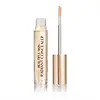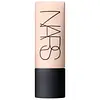What's inside
What's inside
 Key Ingredients
Key Ingredients

 Benefits
Benefits

 Concerns
Concerns

 Ingredients Side-by-side
Ingredients Side-by-side

Water
Skin ConditioningDicaprylyl Ether
EmollientPolyglyceryl-3 Polyricinoleate
EmulsifyingGlycerin
HumectantCoco-Caprylate/Caprate
EmollientPolyglyceryl-3 Diisostearate
EmulsifyingNiacinamide
SmoothingMica
Cosmetic ColorantHydrogenated Castor Oil
EmollientAcacia Decurrens/Jojoba/Sunflower Seed Wax Polyglyceryl-3 Esters
EmollientCollagen
MoisturisingMagnesium Sulfate
Silica
AbrasiveLauroyl Lysine
Skin ConditioningAluminum Hydroxide
EmollientSqualane
EmollientLevulinic Acid
PerfumingSodium Dehydroacetate
PreservativeSodium Levulinate
Skin ConditioningTocopherol
AntioxidantSodium Lauroyl Glutamate
Camellia Japonica Seed Oil
EmollientHydrolyzed Sodium Hyaluronate
Skin ConditioningHelianthus Annuus Seed Oil
EmollientLysine
Skin ConditioningParfum
MaskingMagnesium Chloride
Sorbitol
HumectantPropanediol
SolventCaprylic/Capric Triglyceride
MaskingCetyl Palmitate
Emollient1,2-Hexanediol
Skin ConditioningCaprylyl Glycol
EmollientPolysorbate 80
EmulsifyingSorbitan Stearate
EmulsifyingXanthan Gum
EmulsifyingSodium Benzoate
MaskingCitric Acid
BufferingHydrogenated Lecithin
EmulsifyingAscorbic Acid
AntioxidantColloidal Gold
AntimicrobialGlutathione
Palmitoyl Tetrapeptide-10
Skin ConditioningCI 77891
Cosmetic ColorantIron Oxides
Water, Dicaprylyl Ether, Polyglyceryl-3 Polyricinoleate, Glycerin, Coco-Caprylate/Caprate, Polyglyceryl-3 Diisostearate, Niacinamide, Mica, Hydrogenated Castor Oil, Acacia Decurrens/Jojoba/Sunflower Seed Wax Polyglyceryl-3 Esters, Collagen, Magnesium Sulfate, Silica, Lauroyl Lysine, Aluminum Hydroxide, Squalane, Levulinic Acid, Sodium Dehydroacetate, Sodium Levulinate, Tocopherol, Sodium Lauroyl Glutamate, Camellia Japonica Seed Oil, Hydrolyzed Sodium Hyaluronate, Helianthus Annuus Seed Oil, Lysine, Parfum, Magnesium Chloride, Sorbitol, Propanediol, Caprylic/Capric Triglyceride, Cetyl Palmitate, 1,2-Hexanediol, Caprylyl Glycol, Polysorbate 80, Sorbitan Stearate, Xanthan Gum, Sodium Benzoate, Citric Acid, Hydrogenated Lecithin, Ascorbic Acid, Colloidal Gold, Glutathione, Palmitoyl Tetrapeptide-10, CI 77891, Iron Oxides
Water
Skin ConditioningDimethicone
EmollientMethyl Methacrylate Crosspolymer
Trimethylsiloxysilicate
EmollientGlycerin
HumectantLauryl PEG-9 Polydimethylsiloxyethyl Dimethicone
Skin ConditioningSodium Chloride
MaskingBis-Butyldimethicone Polyglyceryl-3
CleansingOryza Sativa Bran Extract
Skin ConditioningHelianthus Annuus Extract
EmollientRosmarinus Officinalis Leaf Extract
AntimicrobialPlankton Extract
Skin ConditioningAlteromonas Ferment Extract
Skin ConditioningPEG-12 Dimethicone
Skin ConditioningPEG-10 Dimethicone
Skin ConditioningButylene Glycol
HumectantAluminum Hydroxide
EmollientPolysilicone-2
Disteardimonium Hectorite
StabilisingCI 77120
Cosmetic ColorantTocopherol
AntioxidantHydrogen Dimethicone
Sodium Acetylated Hyaluronate
HumectantAlumina
AbrasiveGlucose
HumectantHydrolyzed Pea Protein
EmollientSodium Succinate
BufferingPhenoxyethanol
PreservativeIron Oxides
CI 77492
Cosmetic ColorantCI 77499
Cosmetic ColorantMica
Cosmetic ColorantCI 77891
Cosmetic ColorantWater, Dimethicone, Methyl Methacrylate Crosspolymer, Trimethylsiloxysilicate, Glycerin, Lauryl PEG-9 Polydimethylsiloxyethyl Dimethicone, Sodium Chloride, Bis-Butyldimethicone Polyglyceryl-3, Oryza Sativa Bran Extract, Helianthus Annuus Extract, Rosmarinus Officinalis Leaf Extract, Plankton Extract, Alteromonas Ferment Extract, PEG-12 Dimethicone, PEG-10 Dimethicone, Butylene Glycol, Aluminum Hydroxide, Polysilicone-2, Disteardimonium Hectorite, CI 77120, Tocopherol, Hydrogen Dimethicone, Sodium Acetylated Hyaluronate, Alumina, Glucose, Hydrolyzed Pea Protein, Sodium Succinate, Phenoxyethanol, Iron Oxides, CI 77492, CI 77499, Mica, CI 77891
Ingredients Explained
These ingredients are found in both products.
Ingredients higher up in an ingredient list are typically present in a larger amount.
Aluminum Hydroxide is a form of aluminum. It can be naturally found in nature as the mineral gibbsite. In cosmetics, Aluminum Hydroxide is used as a colorant, pH adjuster, and absorbent.
As a colorant, Aluminum Hydroxide may add opacity, or reduce the transparency. Aluminum hydroxide is contains both basic and acidic properties.
According to manufacturers, this ingredient is an emollient and humectant. This means it helps hydrate the skin.
In medicine, this ingredient is used to help relieve heartburn and help heal ulcers.
There is currently no credible scientific evidence linking aluminum hydroxide in cosmetics to increased cancer risk.
Major health organizations allow the use of aluminum hydroxide in personal care products and have not flagged it as a carcinogenic risk at typical usage levels.
Learn more about Aluminum HydroxideCi 77891 is a white pigment from Titanium dioxide. It is naturally found in minerals such as rutile and ilmenite.
It's main function is to add a white color to cosmetics. It can also be mixed with other colors to create different shades.
Ci 77891 is commonly found in sunscreens due to its ability to block UV rays.
Learn more about CI 77891Glycerin is already naturally found in your skin. It helps moisturize and protect your skin.
A study from 2016 found glycerin to be more effective as a humectant than AHAs and hyaluronic acid.
As a humectant, it helps the skin stay hydrated by pulling moisture to your skin. The low molecular weight of glycerin allows it to pull moisture into the deeper layers of your skin.
Hydrated skin improves your skin barrier; Your skin barrier helps protect against irritants and bacteria.
Glycerin has also been found to have antimicrobial and antiviral properties. Due to these properties, glycerin is often used in wound and burn treatments.
In cosmetics, glycerin is usually derived from plants such as soybean or palm. However, it can also be sourced from animals, such as tallow or animal fat.
This ingredient is organic, colorless, odorless, and non-toxic.
Glycerin is the name for this ingredient in American English. British English uses Glycerol/Glycerine.
Learn more about GlycerinMica is a naturally occurring mineral used to add shimmer and color in cosmetics. It can also help improve the texture of a product or give it an opaque, white/silver color.
Serecite is the name for very fine but ragged grains of mica.
This ingredient is often coated with metal oxides like titanium dioxide. Trace amounts of heavy metals may be found in mica, but these metals are not harmful in our personal products.
Mica has been used since prehistoric times throughout the world. Ancient Egyptian, Indian, Greek, Roman, Aztec, and Chinese civilizations have used mica.
Learn more about MicaTocopherol (also known as Vitamin E) is a common antioxidant used to help protect the skin from free-radicals and strengthen the skin barrier. It's also fat soluble - this means our skin is great at absorbing it.
Vitamin E also helps keep your natural skin lipids healthy. Your lipid skin barrier naturally consists of lipids, ceramides, and fatty acids. Vitamin E offers extra protection for your skin’s lipid barrier, keeping your skin healthy and nourished.
Another benefit is a bit of UV protection. Vitamin E helps reduce the damage caused by UVB rays. (It should not replace your sunscreen). Combining it with Vitamin C can decrease sunburned cells and hyperpigmentation after UV exposure.
You might have noticed Vitamin E + C often paired together. This is because it is great at stabilizing Vitamin C. Using the two together helps increase the effectiveness of both ingredients.
There are often claims that Vitamin E can reduce/prevent scarring, but these claims haven't been confirmed by scientific research.
Learn more about TocopherolWater. It's the most common cosmetic ingredient of all. You'll usually see it at the top of ingredient lists, meaning that it makes up the largest part of the product.
So why is it so popular? Water most often acts as a solvent - this means that it helps dissolve other ingredients into the formulation.
You'll also recognize water as that liquid we all need to stay alive. If you see this, drink a glass of water. Stay hydrated!
Learn more about WaterThis ingredient is a combination of red, black, and yellow iron oxide pigments. This combination of colors is usually found in foundation, because it results in a "skin" color.